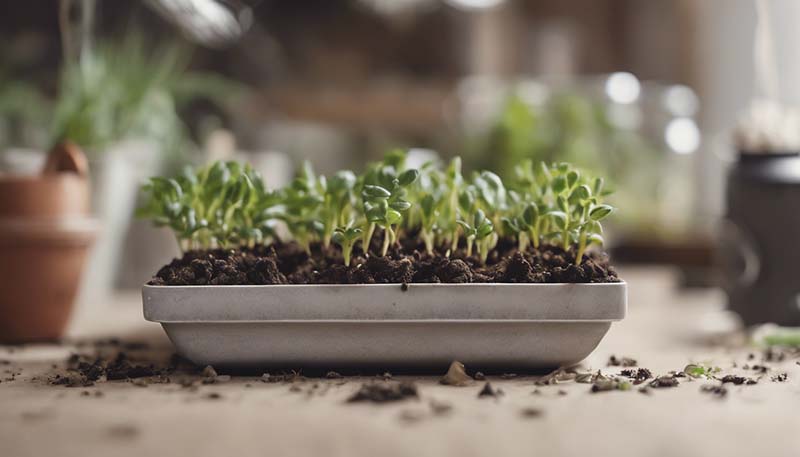Understanding Indoor Gardening Soil Types
Welcome to the intricate world of indoor gardening, where the right soil can make all the difference in the health and productivity of your plants. Soil is the foundation of any garden, and understanding the various types available to you is crucial for success. In this comprehensive guide, we'll explore the characteristics of different indoor gardening soil types, their benefits, and how to choose the one that's best for your specific plants and needs.
The Importance of Soil in Indoor Gardening
Soil is more than just a medium for plants to anchor their roots; it's a complex ecosystem teeming with microorganisms, nutrients, and minerals that support plant growth. For indoor gardens, where environmental conditions can be tightly controlled, the choice of soil becomes even more critical.
Advertisement
Key Factors in Soil Selection
- Drainage: Proper drainage prevents root rot and ensures that plants receive the right amount of water.
- Aeration: Good aeration allows roots to breathe and take up nutrients efficiently.
- Nutrient Content: The soil should be rich in essential nutrients for plant growth.
- pH Level: Different plants have different pH preferences, which can affect nutrient availability.
- Texture: The soil should be light enough to facilitate root penetration but also hold onto moisture.
Types of Indoor Gardening Soil
1. Potting Mix
Potting mix is a blend of different components designed specifically for container gardening. It's lightweight, well-aerated, and provides good drainage. Most potting mixes contain a mix of peat moss, vermiculite, perlite, and compost to create a well-draining, nutrient-rich environment for plants.
2. Coco Coir
Coco coir, made from coconut husks, is an excellent soil alternative that holds moisture well and is highly sustainable. It's often mixed with other components to improve aeration and drainage. Coco coir is pH neutral, making it suitable for a wide range of plants.
3. Perlite and Vermiculite
Both perlite and vermiculite are inorganic substances that are added to soil to improve aeration and drainage. Perlite is a white, lightweight material that helps soil drain better, while vermiculite is a mineral that can absorb water and nutrients, making it useful for retaining moisture.
4. Soilless Mixes
Soilless mixes are composed entirely of organic materials and are free from natural soil. They often include ingredients like peat moss, bark, and compost. These mixes are popular among indoor gardeners because they can be tailored to specific plant needs and are less prone to pests and diseases.
5. Hydroponic Solutions
Hydroponics is a soil-free method of growing plants using mineral nutrient solutions in a water solvent. This method allows for precise control over nutrient delivery and can lead to faster growth and higher yields. However, it requires more technical knowledge and equipment compared to traditional soil-based gardening.

6. Self-Watering Soil
Self-watering soil types incorporate a wicking material or a water reservoir to provide plants with a consistent water supply. These soils are ideal for indoor gardens, especially for those who may not be able to water their plants daily.
Choosing the Right Soil for Your Indoor Garden
When selecting the right soil for your indoor garden, consider the specific needs of your plants. Here are some guidelines to follow:
- Plant Type: Some plants, like succulents, require well-draining soil, while others, like ferns, prefer consistently moist conditions.
- Container: The type of container you use can influence your soil choice. For example, deep pots may require a soil with more drainage capabilities.
- Maintenance: If you prefer low-maintenance gardening, consider a soil mix that retains moisture and nutrients for longer periods.
- Cost: Soil types can vary in cost, so consider your budget when making a selection.
Tips for Successful Indoor Gardening with Soil
Here are some tips to ensure your indoor plants thrive with the right soil:
- Test the pH: Regularly test the pH of your soil to ensure it's within the optimal range for your plants.
- Repotting: Be mindful of when to repot your plants. Over time, soil can become compacted, leading to poor drainage and aeration.
- Aeration: Regularly loosen the top layer of soil to promote air penetration and root growth.
- Fertilize: Use appropriate fertilizers to replenish nutrients in the soil, especially if you're using a fast-draining mix.
- Monitor Moisture: Keep an eye on soil moisture levels to prevent overwatering or underwatering.
Conclusion
Understanding indoor gardening soil types is an essential step towards creating a thriving indoor garden. By considering the key factors in soil selection, choosing the right soil for your plants, and following best practices for soil care, you can provide your indoor plants with the foundation they need to grow and flourish.
Happy gardening!
Comment